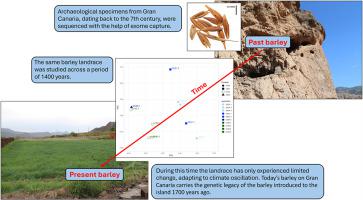当前位置:
X-MOL 学术
›
Journal of Archaeological Science
›
论文详情
Our official English website, www.x-mol.net, welcomes your
feedback! (Note: you will need to create a separate account there.)
Utilising ancient DNA to understand crop population dynamics across a millennium: A case study of archaeological barley (Hordeum vulgare L.) from Gran Canaria, Spain
Journal of Archaeological Science ( IF 2.6 ) Pub Date : 2024-05-18 , DOI: 10.1016/j.jas.2024.106001 Jenny Hagenblad , Jacob Morales , Matti W. Leino , Robin Abbey-Lee , Amelia C. Rodríguez-Rodríguez , Jonathan Santana
Journal of Archaeological Science ( IF 2.6 ) Pub Date : 2024-05-18 , DOI: 10.1016/j.jas.2024.106001 Jenny Hagenblad , Jacob Morales , Matti W. Leino , Robin Abbey-Lee , Amelia C. Rodríguez-Rodríguez , Jonathan Santana

|
Landraces are described as genetically diverse, dynamic populations of unimproved crops. However, studying the development of a landrace population over longer periods of time has rarely been done due to a lack of suitable archaeological materials. The indigenous grain silos of Gran Canaria provide a unique opportunity for genetically analysing multiple specimens from the same time period as well as sampling the same population at multiple time points. Here we report a genetic study of a landrace barley ( L.) sampled repeatedly over a period of 1400 years. We successfully enriched extracted aDNA for the barley exome using capture techniques and present sequencing data from ten archaeological and six extant samples. The results show that the landrace barley population of Gran Canaria has not undergone any dramatic genetic turnover or influx of new genetic material since the 7th century CE, but that the scale of cultivation seems to have varied. We detect smaller temporal changes of the genetic composition during the studied period and suggest that these changes reflect natural selection for adaptation to a changing climate and a dynamic agricultural society.
中文翻译:

利用古代 DNA 了解千年来作物种群动态:西班牙大加那利岛考古大麦 (Hordeum vulgare L.) 的案例研究
地方品种被描述为遗传多样性、动态的未经改良作物群体。然而,由于缺乏合适的考古材料,对地方种族种群在较长时期内的发展的研究很少进行。大加那利岛的本土粮仓提供了一个独特的机会,可以对同一时期的多个样本进行基因分析,并在多个时间点对同一种群进行采样。在此,我们报告了一项对地方品种大麦 (L.) 进行的基因研究,该研究在 1400 年的时间里反复取样。我们使用捕获技术成功地富集了大麦外显子组的提取 aDNA,并提供了来自 10 个考古样本和 6 个现存样本的测序数据。结果表明,自公元七世纪以来,大加那利岛的地方品种大麦种群没有经历任何显着的遗传更替或新遗传物质的流入,但种植规模似乎有所不同。我们在研究期间检测到遗传组成的较小时间变化,并表明这些变化反映了适应气候变化和动态农业社会的自然选择。
更新日期:2024-05-18
中文翻译:

利用古代 DNA 了解千年来作物种群动态:西班牙大加那利岛考古大麦 (Hordeum vulgare L.) 的案例研究
地方品种被描述为遗传多样性、动态的未经改良作物群体。然而,由于缺乏合适的考古材料,对地方种族种群在较长时期内的发展的研究很少进行。大加那利岛的本土粮仓提供了一个独特的机会,可以对同一时期的多个样本进行基因分析,并在多个时间点对同一种群进行采样。在此,我们报告了一项对地方品种大麦 (L.) 进行的基因研究,该研究在 1400 年的时间里反复取样。我们使用捕获技术成功地富集了大麦外显子组的提取 aDNA,并提供了来自 10 个考古样本和 6 个现存样本的测序数据。结果表明,自公元七世纪以来,大加那利岛的地方品种大麦种群没有经历任何显着的遗传更替或新遗传物质的流入,但种植规模似乎有所不同。我们在研究期间检测到遗传组成的较小时间变化,并表明这些变化反映了适应气候变化和动态农业社会的自然选择。


















































 京公网安备 11010802027423号
京公网安备 11010802027423号